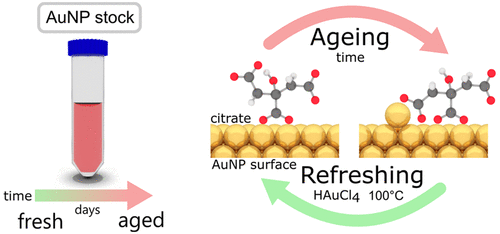Our official English website, www.x-mol.net, welcomes your feedback! (Note: you will need to create a separate account there.)
Citrate Coordination and Bridging of Gold Nanoparticles: The Role of Gold Adatoms in AuNP Aging.
ACS Nano ( IF 17.1 ) Pub Date : 2020-06-16 , DOI: 10.1021/acsnano.0c03050 David-Benjamin Grys 1 , Bart de Nijs 1 , Andrew R Salmon 1 , Junyang Huang 1 , Wenting Wang 1 , Wei-Hsin Chen 1 , Oren A Scherman 2 , Jeremy J Baumberg 1
ACS Nano ( IF 17.1 ) Pub Date : 2020-06-16 , DOI: 10.1021/acsnano.0c03050 David-Benjamin Grys 1 , Bart de Nijs 1 , Andrew R Salmon 1 , Junyang Huang 1 , Wenting Wang 1 , Wei-Hsin Chen 1 , Oren A Scherman 2 , Jeremy J Baumberg 1
Affiliation

|
Gold nanoparticles used in many types of nanostructure are mostly stabilized by citrate ligands. Fully understanding their dynamic surface chemistry is thus essential for applications, particularly since aging is frequently a problem. Using surface-enhanced Raman spectroscopy in conjunction with density functional theory calculations, we are able to determine Au–citrate coordination in liquid with minimal invasiveness. We show that citrate coordination is mostly bidentate and simply controlled by its protonation state. More complex binding motifs are caused by interfering chloride ions and gold adatoms. With increasing age of stored gold nanoparticle suspensions, gold adatoms are found to move atop the Au facets and bind to an additional terminal carboxylate of the citrate. Aged nanoparticles are fully refreshed by removing these adatoms, using etching and subsequent boiling of the gold nanoparticles.
中文翻译:

金纳米粒子的柠檬酸盐配位和桥联:金原子在AuNP老化中的作用。
在许多类型的纳米结构中使用的金纳米颗粒大多由柠檬酸盐配体稳定。因此,充分了解其动态表面化学性质对于应用至关重要,特别是因为老化经常是一个问题。使用表面增强拉曼光谱结合密度泛函理论计算,我们能够以最小的侵入性确定液体中的金柠檬酸盐配位。我们表明,柠檬酸盐的配位主要是二齿的,并且仅受其质子化状态控制。较复杂的结合基序是由干扰氯离子和金原子构成的。随着储存的金纳米颗粒悬浮液年龄的增加,发现金原子会移动到Au面上,并与柠檬酸盐的另一个末端羧酸盐结合。去除这些吸附原子,可以使陈旧的纳米颗粒完全焕发活力,
更新日期:2020-07-28
中文翻译:

金纳米粒子的柠檬酸盐配位和桥联:金原子在AuNP老化中的作用。
在许多类型的纳米结构中使用的金纳米颗粒大多由柠檬酸盐配体稳定。因此,充分了解其动态表面化学性质对于应用至关重要,特别是因为老化经常是一个问题。使用表面增强拉曼光谱结合密度泛函理论计算,我们能够以最小的侵入性确定液体中的金柠檬酸盐配位。我们表明,柠檬酸盐的配位主要是二齿的,并且仅受其质子化状态控制。较复杂的结合基序是由干扰氯离子和金原子构成的。随着储存的金纳米颗粒悬浮液年龄的增加,发现金原子会移动到Au面上,并与柠檬酸盐的另一个末端羧酸盐结合。去除这些吸附原子,可以使陈旧的纳米颗粒完全焕发活力,



























 京公网安备 11010802027423号
京公网安备 11010802027423号